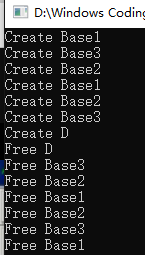C++——Inheritence
一种错误的观念:
子类继承父类,只把父类的公有成员继承下来,私有的不会继承。
事实上无论是如何继承,都会把父类的所有成员继承下来。

1 #include<iostream> 2 using namespace std; 3 4 class Base { 5 private: 6 int x; 7 }; 8 9 class D :private Base{ 10 public: 11 int y; 12 }; 13 14 int main() 15 { 16 cout << sizeof(Base) << endl; 17 cout << sizeof(D) << endl; 18 return 0; 19 }
输出结果:4 8
继承关系要看2点,见下图
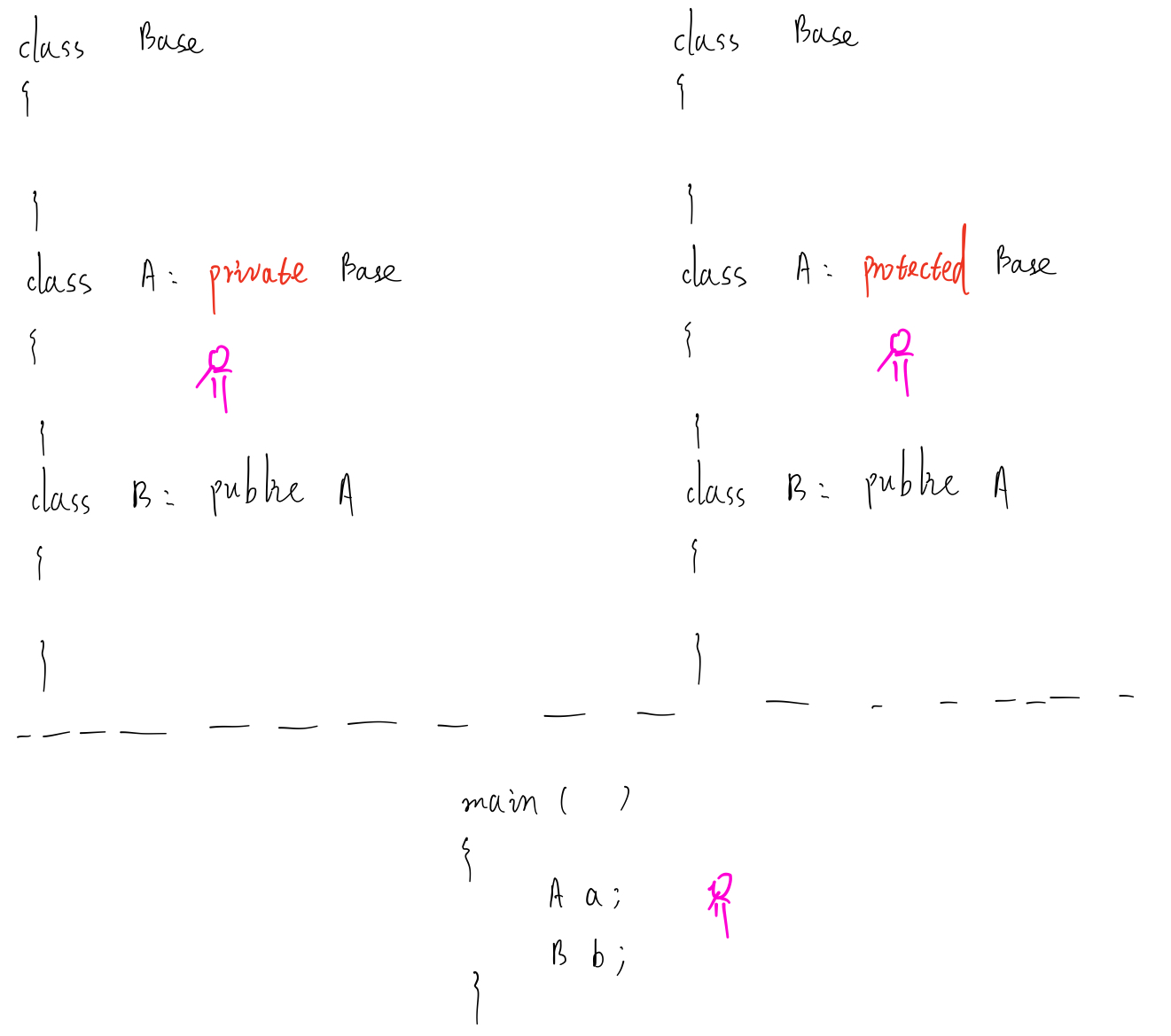
对于继承关键字,我门只需要写一次,但是用的时候却要看2次。见上图2个小人,一个看子类内部通过继承关键字如何看代父类。一个是子类对象通过继承关键字如何看代父类。
不管使用何种继承方式,父类私有数据成员,子类内部都是不能直接访问的。可以通过父类的共有方法间接访问父类私有数据。这里有一点需要注意,假如是private继承父类,父类里面protected数据或方法、public数据或方法、private方法都是可以直接访问的。 这时候如果站在子类内部那个小人的角度看问题,private和protected表现行为差不多。那protected和private区别在哪?
区别在孙子类那里,如果是private继承,Base父类在儿子A那里都是私有的,到了孙子B那里父类无论是数据还是方法都访问不了了。相当于private关键字割断了继承关系,整个继承家族到儿子辈就绝后了。如果是protected就可以保障继承关系不断。
private指定的属性 或 方法,将不能被继承。
protected指定的属性 或 方法,将在类外部不可见,但可以被继承。
派生类的构造函数与析构函数调用顺序
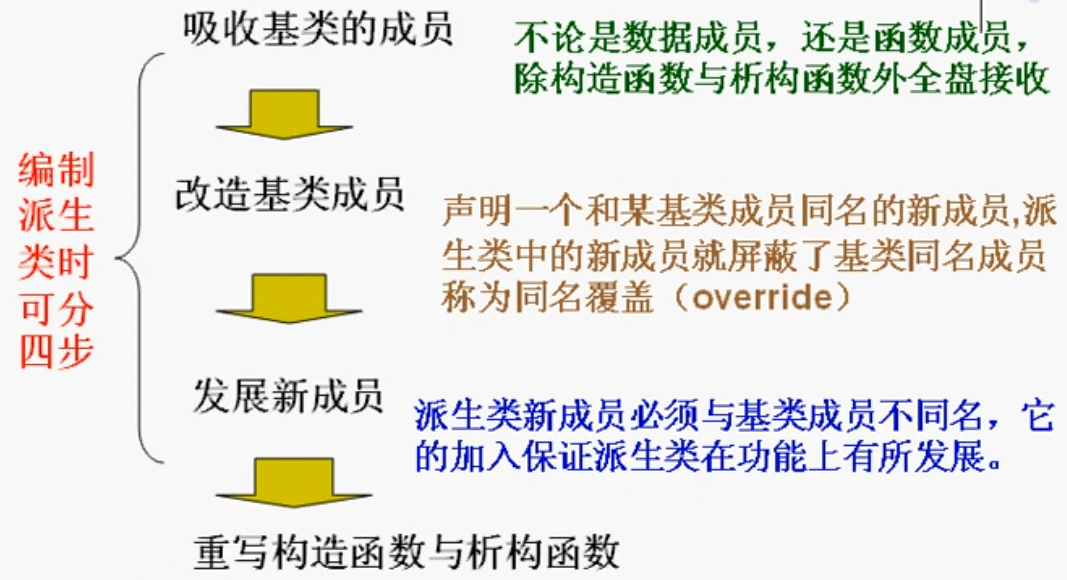
注:图片中 同名覆盖改为同名隐藏

#include<iostream> using namespace std; class Base1 { public: Base1() { cout << "Create Base1" << endl; } ~Base1() { cout << "Free Base1" << endl; } }; class Base2 { public: Base2() { cout << "Create Base2" << endl; } ~Base2() { cout << "Free Base2" << endl; } }; class Base3 { public: Base3() { cout << "Create Base3" << endl; } ~Base3() { cout << "Free Base3" << endl; } }; class D :public Base2, public Base1, public Base3 { public: D() { cout << "Create D" << endl; } ~D() { cout << "Free D" << endl; } private: Base1 b1; Base2 b2; Base3 b3; }; int main(int argc, char *argv[]) { D d; return 0; }

如果你继承的父类不提供默认或者缺省的构造函数,我们就必须使用参数列表的形式对父类进行构造。参数列表相当于再调用父类的构造函数。
千万不要把参数列表那里的父类构造函数放到子类构造函数里面,那样代表先完成子类构造再完成父类构造。爸爸还没生出来来,怎么会有儿子呢?

#include<iostream> using namespace std; class Base1 { public: Base1(int d=0):x(d) { cout << "Create Base1" << endl; } ~Base1() { cout << "Free Base1" << endl; } private: int x; }; class Base2 { public: Base2(int d = 0):y(d) { cout << "Create Base2" << endl; } ~Base2() { cout << "Free Base2" << endl; } private: int y; }; class Base3 { public: Base3(int d = 0):z(d) { cout << "Create Base3" << endl; } ~Base3() { cout << "Free Base3" << endl; } private: int z; }; class D :public Base2, public Base1, public Base3 { public: D(int data):Base1(data), Base2(data), Base3(data),b1(data), b2(data), b3(data) { cout << "Create D" << endl; } ~D() { cout << "Free D" << endl; } private: Base1 b1; Base2 b2; Base3 b3; }; int main(int argc, char *argv[]) { D d(10); return 0; }
参数列表那里的构造函数顺序任意写。决定构造函数顺序只有2处:①继承声明时的顺序②类内部数据成员的顺序。
对于多继承,某一数据成员可能在多个父亲中存在定义。在子类中访问父类数据成员时会存在二义性。下面代码演示,这段代码编译不过

#include<iostream> using namespace std; class B1 { public: B1(int d=0):n(d) {} ~B1() {} public: int n; }; class B2 { public: B2(int d = 0):n(d) {} ~B2() {} public: int n; }; class D :public B2, public B1 { public: D():x(0) {} ~D() {} private: int x; }; int main(int argc, char *argv[]) { D d; d.n=10; return 0; }
这种情况需要指明到底是哪个父类的数据成员

#include<iostream> using namespace std; class B1 { public: B1(int d=0):n(d) {} ~B1() {} public: int n; }; class B2 { public: B2(int d = 0):n(d) {} ~B2() {} public: int n; }; class D :public B2, public B1 { public: D():x(0) {} ~D() {} private: int x; }; int main(int argc, char *argv[]) { D d; d.B1::n=10; return 0; }
钻石继承

#include<iostream> using namespace std; class B0 { public: B0(int d=0):m(d) {} ~B0() {} public: int m; }; class B1:public B0 { public: B1(int d = 0):n(d) {} ~B1() {} public: int n; }; class B2 :public B0 { public: B2(int d = 0) :n(d) {} ~B2() {} public: int n; }; class D :public B2, public B1 { public: D():x(0) {} ~D() {} private: int x; }; int main(int argc, char *argv[]) { D d; d.B1::n=10; d.B1::m = 20; return 0; }
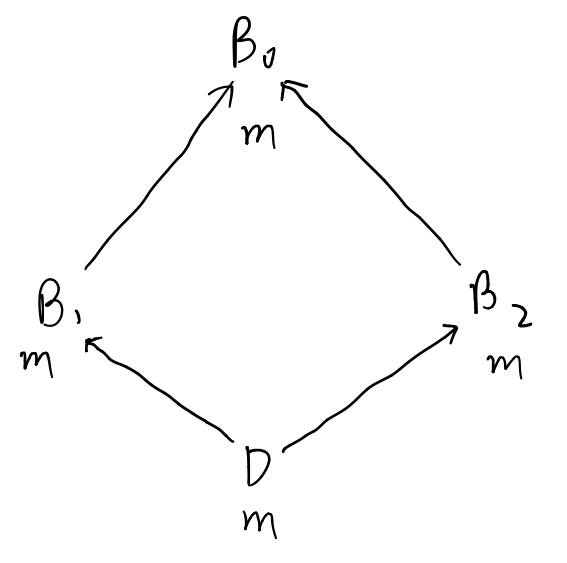

类B1,B2都有m,所以D中要想使用m必须指定具体是哪个类的m
使用virtual关键字,让整个钻石继承使用一个数据成员。这种继承叫虚拟继承

#include<iostream> using namespace std; class B0 { public: B0(int d=0):m(d) {} ~B0() {} public: int m; }; class B1: virtual public B0 { public: B1(int d = 0):n(d) {} ~B1() {} public: int n; }; class B2 : virtual public B0 { public: B2(int d = 0) :n(d) {} ~B2() {} public: int n; }; class D :public B2, public B1 { public: D():x(0) {} ~D() {} private: int x; }; int main(int argc, char *argv[]) { D d; d.B1::n=10; d.m = 20; return 0; }
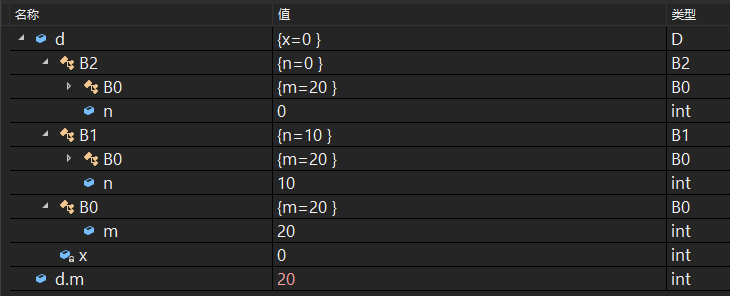
在派生类对象的创建中,首先是虚基类的构造函数并按它们声明的顺序构造。第二批是非虚基类的构造函数按它们声明的顺序调用。第三批是成员对象的构造函数。最后是派生类自己的构造函数被调用

#include<iostream> using namespace std; class Base1 { public: Base1() { cout << "Create Base1" << endl; } ~Base1() { cout << "Free Base1" << endl; } }; class Base2 { public: Base2() { cout << "Create Base2" << endl; } ~Base2() { cout << "Free Base2" << endl; } }; class Base3 { public: Base3() { cout << "Create Base3" << endl; } ~Base3() { cout << "Free Base3" << endl; } }; class D :public Base2, virtual public Base1, virtual public Base3 { public: D() { cout << "Create D" << endl; } ~D() { cout << "Free D" << endl; } private: Base1 b1; Base2 b2; Base3 b3; }; int main(int argc, char *argv[]) { D d; return 0; }
